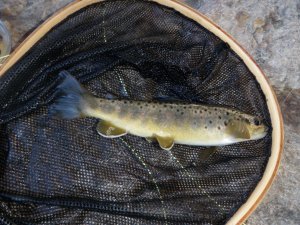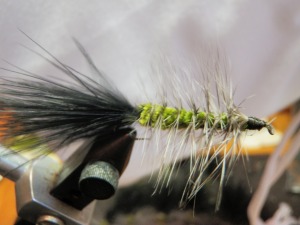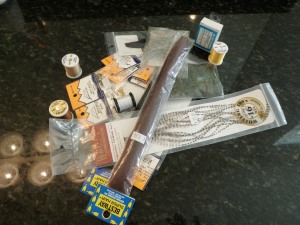Time: 12:00PM – 2:30PM
Location: Hidden Valley Exit Off of Interstate 70
Fish Landed: 2
Web Album Link
The days remaining in 2011 were dwindling, particularly the days nice enough to get out on a stream and fish. With unseasonably warm days forecast for Thursday and Friday, November 17-18 I cleared an afternoon on Friday to resume my quest to surpass the 2010 cumulative fish count. I wanted a destination within an hour of Denver and limited my options to Clear Creek, Bear Creek or the South Platte River. The South Platte flows were extremely low at 50 cfs, and that makes for difficult fishing. Bear Creek is a very small stream, and low fall conditions would make this a challenge as well. By process of elimination I chose Clear Creek.
I left work at 10:30AM, returned home and tossed all my fishing gear in the Santa Fe including a lunch. I arrived at the Hidden Valley exit off of interstate 70 at noon and parked at the bike path trailhead and ate my lunch. I was on the water by 12:15 and elected to walk down the path to a place where the stream fans out into a nice slow moving deep pool. I discovered there was a five foot wide ice ledge along the side that I was fishing from. The water wasn’t very deep so I tied on a parachute hopper and added a beadhead hares ear and then a RS2 as the point fly.
I began casting to the main central run and drifting my flies along the seams into the center of the pool as it fanned out into the deepest section but I had no results. Next I probed the deep water within a couple feet of the ice shelf and moved to the top of the pool with no success. I hiked along the bike trail toward the car and dropped down to a couple sections where there were nice deep slow moving troughs along the south bank, and again did not experience any success. In fact, I did not spot a single fish and the area I was fishing was totally covered by the shadows of the hills running along the south side of the narrow valley.
When I arrived at the car, I carefully picked my way down the steep bank and fished the nice wide deep pool below the parking area. Judging from the well worn paths, this area received a lot of pressure, and sure enough I couldn’t connect with any fish in spite of thorough prospecting of the tail, midsection, and top of the area. This pool had a wider shelf of ice along my side of the stream, and I broke a few chunks loose in order to wade closer to the top of the pool for some nice drifts.
Catching number 531 was beginning to look quite bleak as I contemplated my next move. The stream made a forty-five degree bend to the north and then flowed under the on ramp to I70 and then under the eastbound and westbound lanes of the highway. It appeared that the sun was hitting Clear Creek on the other side of the highway, so I decided to make my way under the highway and explore the north side. As I approached the first bridge I noticed some nice short pockets so I unclipped the flies and tossed a cast along the left bank. As I lifted my rod to make a second cast, I felt a throb and set the hook and spotted a small brown thrashing in the water. Could this be the one? Unfortunately when I brought the fish to my net I noticed that the tiny RS2 was embedded in the side of the small brown, and I’d foul hooked the fish. I’d rather settle for a tie than count a foul hooked fish so I quickly released the fish and resumed my quest.
At least I’d now found evidence that fish were in the stream and perhaps showing some interest in following a fly and eating. I was beginning to doubt the dry/dropper strategy, but before switching to an indicator and fishing deeper, I decided to fish the existing flies in the shadows under the highway. I could switch to deep nymphs once I exited to the sunny north side. There was a nice deep slot opposite where I’d foul hooked the small brown so I waded into the stream a bit and cast the hopper and nymphs to the top of the slot and let it drift to the tail. Just as the flies began to drag at the tail I noticed a flash and set the hook and played a nine inch brown trout to my net. This fish was hooked in the mouth by the RS2 and represented the much sought after number 531 for the 2011 season. I photographed the brown on top of a nice waist high rock and released it to resume its winter survival ordeal.

Fish That Put Me Over the Top
I moved up along the stream a bit further and in short order discovered that my landing net was no longer clipped to my Fishpond front pack configuration. Apparently in my euphoria over catching a fish, I’d forgotten that the net was decoupled, and I’d allowed it to drift down the stream. I was cursing myself as I retraced my steps to the large rock, and sure enough it wasn’t visible. I’d lowered the fish in the net to the water, removed the hook, released the fish and gathered my line while allowing the net to drift away. Could I walk downstream and find the net lodged on a rock or stick? I was skeptical but decided to scramble downstream to the car and have a look. Fortunately when I got to the parking area and looked downstream I saw my net lodged against a large rock protruding above some shallow riffles. I quickly scrambled down the bank and waded to the shallow riffle area and retrieved my net.
Next I moved back up under the I70 overpass and fished some additional interesting pockets and slots to no avail. I emerged out of the shadows on the north side of the highway and circled past some wide shallow unattractive areas until I approached a nice area with riffles running three to four feet deep. I made some nice casts here but saw no action and moved to another nice run with some depth along the rocky northeast bank. While standing at the tail of the run, I spotted a small brown briefly look at my fly, but it quickly returned to its holding spot and then ignored more repeated drifts over it.
This provoked me to remove the hopper, and switch to a strike indicator and split shot with the same two nymphs that I’d been fishing below the split shot. I worked the upper part of the run I was in and then moved up to the next attractive water. Here there was a large protruding midstream rock and then eight feet below a large subsurface rock and then a nice soft pocket below that. I drifted the nymphs through the soft pocket repeatedly with not action, and then waded up a bit to cast into the short pocket behind the protruding rock. The combination of the two rocks created a situation where the current was being sucked back upstream against the large rock so my indicator moved back toward the rock and remained stationary. After allowing it to sit motionless for a bit I lifted my rod to recast, but as I did so, a fish grabbed the beadhead hares ear. This fish was around eleven inches and I quickly played it to my recovered net, photographed and released it.

A Second Larger Brown
I continued up the stream a bit further, but the water was largely unattractive as it widened out into shallow riffles. Next I would need to continue underneath the highway into the shadows again, and it was around 2:30 and I wasn’t excited about going back into the shade as the temperatures began to decline so I called it a day satisfied that I’d landed two fish and surpassed my cumulative fish count of 2010.

Nice Stretch of Water North of Interstate 70
Like this:
Like Loading...


















